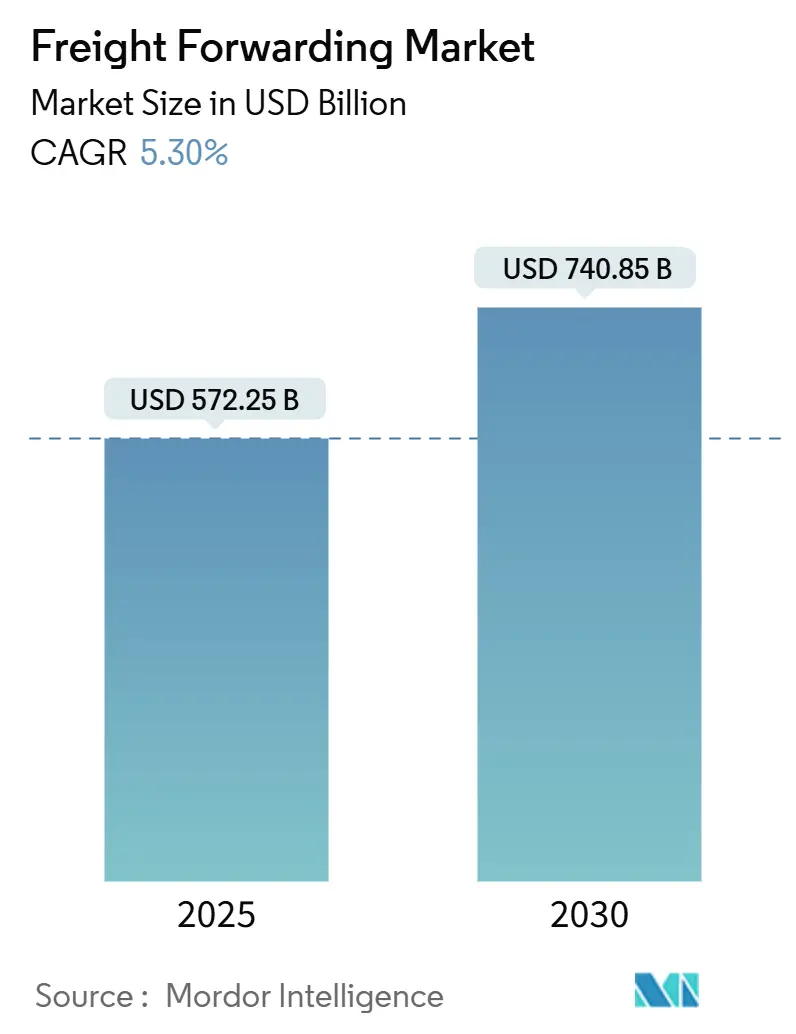
Freight Forwarding Market Analysis by Mordor Intelligence
The Freight Forwarding Market size is estimated at USD 572.25 billion in 2025, and is expected to reach USD 740.85 billion by 2030, at a CAGR of 5.30% during the forecast period (2025-2030).
The upward trajectory continues despite geopolitical tensions and repeated supply-chain shocks because digital platforms, resilient multimodal networks, and sustained e-commerce flows keep volumes intact. Heightened demand for parcel-sized cross-border shipments, steady investment in temperature-controlled capacity, and a structural pivot toward near-shoring all lift volumes in every major trade lane. Second-order effects include faster technology adoption, new premium service tiers built around real-time visibility, and an observed tilt toward consolidation as forwarders strive for scale advantages. M&A activity, spearheaded by DSV’s USD 15.9 billion takeover of DB Schenker in 2025, illustrates how scale and data density now underpin competitive positioning in the freight forwarding market.
Key Report Takeaways
- By mode of transport, ocean freight retained 62% of the Freight Forwarding market share in 2024. The market for multimodal & intermodal forwarding posts the fastest 6.4% CAGR between 2025-2030.
- By enterprise size, large enterprises commanded 70% of the Freight Forwarding market size in 2024. The market for the SME segment is projected to grow at a 6.6% CAGR between 2025-2030.
- By the forwarder model, traditional asset-light players held 82% of the freight forwarding market share in 2024. The market for digital-first platforms are forecast to surge at an 18.0% CAGR between 2025-2030.
- By end-user industry, retail & e-commerce led with a 29% revenue share in 2024. The Freight Forwarding market size for the healthcare & pharmaceuticals is expanding at an 8.5% CAGR between 2025-2030.
Global Freight Forwarding Market Trends and Insights
Drivers Impact Analysis
| Driver | (~) % Impact on CAGR Forecast | Geographic Relevance | Impact Timeline |
|---|---|---|---|
| Surging cross-border e-commerce parcel volumes | +1.8 | Asia-Pacific ➔ North America | Medium term (2-4 years) |
| Near-shoring-led manufacturing shifts | +0.9 | US-Mexico border | Medium term (2-4 years) |
| Direct-to-consumer brand proliferation | +0.7 | North America & Europe | Short term (≤2 years) |
| Reefer capacity expansion for pharma | +1.2 | Europe, North America, emerging markets | Medium term (2-4 years) |
| On-demand grocery & meal-kit services | +0.6 | North America, Europe, urban Asia-Pacific | Short term (≤2 years) |
| Consumer expectation for real-time visibility | +1.1 | Developed markets worldwide | Short term (≤2 years) |
| Source: Mordor Intelligence | |||
Surging Cross-Border E-commerce Parcel Volumes
Record online spending in Asia continues to drive small-parcel flows toward North American consumers. Freight forwarders are repurposing existing facilities into parcel sortation hubs, integrating customs pre-clearance, and layering predictive duty-tax calculators to remove purchase friction. Service speed rather than simple cost now determines routing decisions, encouraging carriers to expand weekly sailings on trans-Pacific express lanes. Value-added features, such as isotopic parcel-level visibility and branded returns, help incumbents defend share against pure-play parcel integrators[1]DHL eCommerce Solutions, “E-tailer’s Almanac 2025,” dhl.com.
Near-shoring-Led Manufacturing Shifts
Proximity manufacturing in Mexico, Poland, and Türkiye pulls freight volumes from long-haul ocean to shorter multimodal corridors. Cross-border truckload demand on the US-Mexico lane grew double digits in 2024, stimulating investments in streamlined border‐clearance software and bonded inland ports. Forwarders with customs brokerage depth monetize complex tariff regimes, while integrated rail-truck solutions shorten door-to-door time by 35% compared with ocean alternatives.
Direct-to-Consumer Brand Proliferation
Thousands of online-only fashion, beauty, and electronics labels now bypass wholesalers, injecting high-order frequency and low average shipment weights into the freight forwarding market. These D2C flows require consolidated export sorting, automated trade documentation, and flexible returns pipelines. Forwarders answer with plug-and-play APIs that sync inventory, duty estimation, and end-customer notifications, thereby minimizing cart abandonment for merchants[2]A.P. Moller–Maersk, “Nearshoring US-Mexico: Rail-Truck Solutions Cut Door-to-Door Transit by 35 Percent,” maersk.com.
Reefer Capacity Expansion for Pharma
Ocean carriers deployed 13% more reefers in 2024 and purpose-built cool-terminals in Antwerp, Shanghai, and Savannah. The additional capacity lets vaccine manufacturers shift from air to sea, trimming carbon footprints and freight spend by up to 50% while preserving GDP compliance. Forwarders certify GDP processes, embed continuous temperature logging, and train staff on specialized handling, capturing premium yields that outpace general cargo margins[3]DHL Global Forwarding, “GDP-Certified Pharma Logistics: End-to-End Cold-Chain Services,” dhl.com.
Restraints Impact Analysis
| Restraint | (~) % Impact on CAGR Forecast | Geographic Relevance | Impact Timeline |
|---|---|---|---|
| Port congestion & container imbalances | –1.2 | Asia-Pacific hubs | Medium term (2-4 years) |
| Global driver shortage | –0.8 | North America & Europe | Long term (≥ 5 years) |
| Accelerated fashion return cycles | –0.3 | North America & Europe | Short term (≤ 2 years) |
| Source: Mordor Intelligence | |||
Port Congestion & Container Imbalances
Extended berth queues, equipment shortages, and unpredictable sailing schedules inflate transit variability. Average dwell time at major Asian ports more than doubled versus 2023, and equipment repositioning now adds an 18-day buffer on several head-haul trades. Forwarders pre-book container slots weeks ahead, negotiate priority gate windows, and charter supplemental feeders to bypass gridlocked hubs. Spot rates on Asia-Europe lanes spiked 255% in early 2025, forcing shippers to rebalance sourcing or absorb cost surges.
Global Driver Shortage
North America is short over 100,000 truck drivers, and European fleets report vacancies topping 425,000 seats. Ageing workforces, stringent safety regulations, and insufficient training pipelines intensify scarcity. Road freight rates climb at double-digit percentages, prompting modal shifts to intermodal rail where viable. Forwarders invest in driver-wellness programs, apprenticeship schemes, and automation trials to secure capacity.
Segment Analysis
By Mode of Transport: Multimodal Integration Reshapes Logistics Strategies
Ocean freight retained a 62% freight forwarding market share in 2024 because it offers the lowest cost per TEU for high-volume goods moving across oceans. The segment benefits from megavessel deployments, automated terminals, and expanded mainline-feeder networks that keep slot costs low. Despite its scale, ocean services face chokepoints, motivating shippers to add rail or air legs when schedule integrity falters. Multimodal solutions therefore log a 6.4% CAGR, as forwarders bundle ocean, rail, and road to shave lead times by two to four days on Asia-Europe lanes. Rail volumes on the Eurasian corridor climbed 10.7% in 2024 and continue to diversify routing risk. Air forwarding still dominates time-critical pharma, electronics, and fashion drops, with capacity rebounding as belly-hold networks rebuild. Road forwarding secures regional distribution and last-mile fulfilment but remains cost-sensitive because fuel surcharges and driver scarcity inflate line-haul rates. Forwarders that orchestrate mode-agnostic routing enjoy higher wallet share and deeper client lock-in across every freight forwarding market region.
The freight forwarding market size for multimodal services is forecast to expand at a CAGR of 6.4% by 2030. Integrated control-tower platforms, unified quoting engines, and block-train charters enhance operational agility and margin retention. Pure ocean or air specialists now partner with intermodal rail operators to keep customers from switching providers. Technology that digitises customs hand-offs, auto-allocates container equipment, and releases arrival notifications in a single dashboard plays a central role. Market leaders report that end-to-end multimodal contracts lift client retention by 22%, highlighting the stickiness of an orchestrated service bundle in the freight forwarding market.
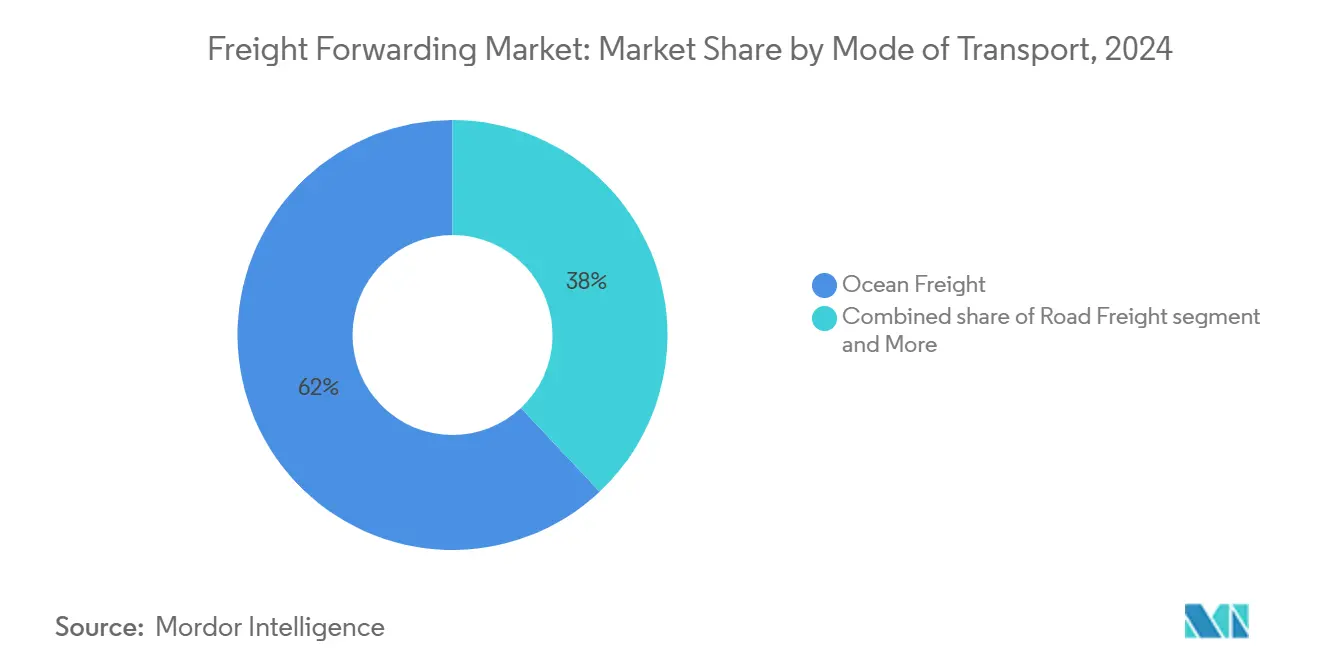
Note: Segment shares of all individual segments available upon report purchase
By Enterprise Size: SMEs Embrace Digital Solutions for Global Reach
Large enterprises captured 70% of the freight forwarding market size in 2024, leveraging yearly tender volumes above 50,000 TEUs to lock in index-linked ocean and air contracts. Their procurement departments demand unified global KPIs and carbon accounting, driving forwarders to build analytics layers atop operational data. Smaller exporters historically lacked negotiating power, but digital marketplaces now aggregate SME demand and auction it to carriers in daily spot buys, cutting freight spends by 12%. This dynamic pushes the SME slice of the freight forwarding market to a 6.6% CAGR. Freight platforms offer instant quotes, milestone alerts, and integrated trade-finance modules that align with SME cash-flow cycles.
SME participation also sharpens compliance needs because novice shippers may misdeclare cargo, inviting fines. Digital documentation wizards flag restricted commodities and pre-populate standard forms, reducing customs holds by 19%. Forwarders diversify revenue by bundling insurance, duty-drawback filing, and e-invoicing into subscription tiers. Large industrial clients still dominate heavyweight project cargo and plant relocation work, but the incremental growth momentum lies with SMEs shipping e-commerce replenish ment and niche finished goods. The freight forwarding market will therefore exhibit a progressively balanced customer portfolio as demand from resource-constrained exporters accelerates.
By Forwarder Model: Digital Platforms Disrupt Traditional Paradigm
Traditional forwarders kept 82% freight forwarding market share in 2024, controlling long-term carrier contracts, in-house customs brokerage licenses, and widespread branch networks. Yet their manual document workflows, legacy TMS modules, and siloed rate engines prevent real-time service elasticity. Digital-first entrants employ cloud-native architecture, AI-driven route optimization, and transparent landed-cost calculators, enabling quote-to-book cycles measured in seconds. These capabilities underpin an 18.0% CAGR through 2030 for online freight platforms.
Incumbents respond by purchasing SaaS startups, deploying low-code applications to automate internal tasks, and rolling out customer portals. Route-planning algorithms now blend cost, transit reliability, and emissions data to optimize booking decisions on a shipment-level basis. Blockchain pilots reduce cargo theft by 38% via immutable chain-of-custody records. Strong cash positions enable large asset-light players to integrate acquired tech stacks quickly, but smaller independents risk marginalization unless they enter cooperative alliances. The freight forwarding industry, therefore, bifurcates into scaled technology leaders and niche specialists that monetize deep vertical know-how.
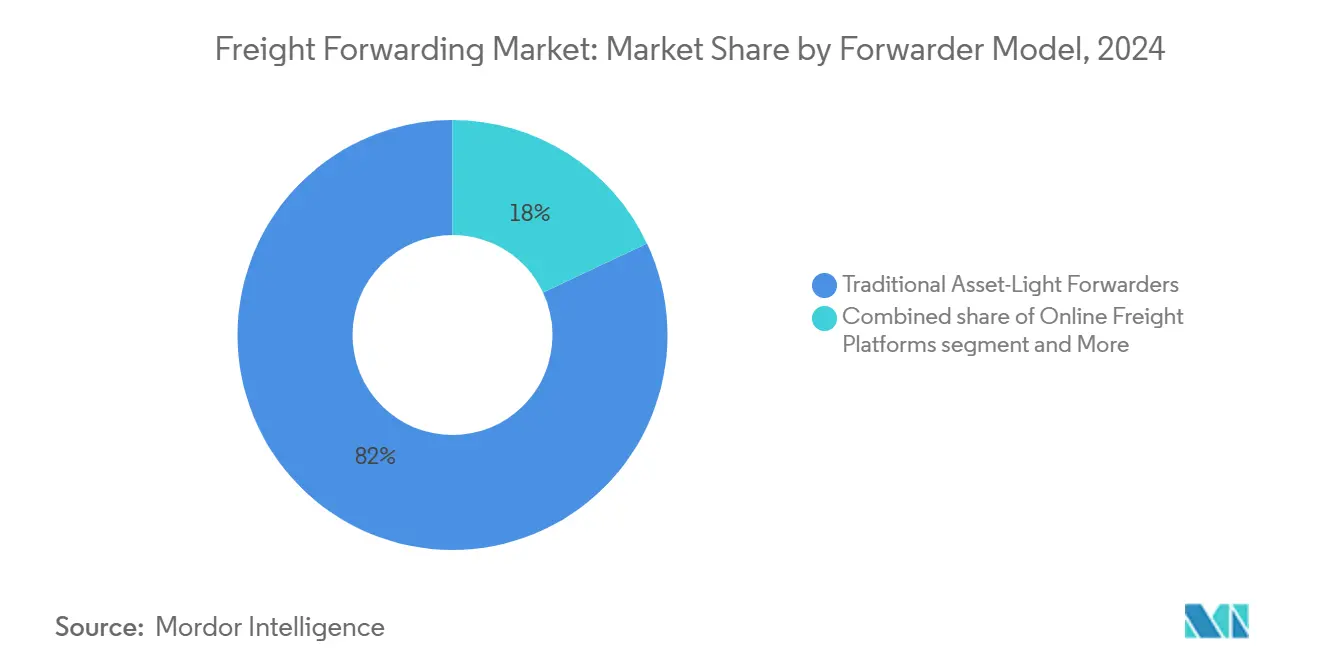
Note: Segment shares of all individual segments available upon report purchase
By End-User Industry: Healthcare Segment Accelerates Amid Cold-Chain Innovation
Retail & e-commerce retained 29% of the freight forwarding market revenue in 2024. Omnichannel merchants pursue short replenishment cycles and multiple origin diversification to reduce geopolitical exposure, keeping order velocity high. Reverse-logistics volumes swell as fashion return rates climb, inflating warehouse labour costs but generating additional handling revenue for forwarders. Healthcare & pharmaceuticals register an 8.5% CAGR through 2030, cementing cold-chain logistics as a premium lane in every freight forwarding market region. Drug makers ship biologics, cell therapies, and temperature-sensitive injectables that cannot tolerate deviation, mandating GDP-certified facilities and validated data-logger chains.
Industrial & manufacturing flows remain critical because complex supply chains still span dozens of sub-tier suppliers that must coordinate just-in-time deliveries. Automotive parts increasingly include high-value battery packs that trigger hazmat protocols and specialized packaging. Food & beverages rely on shared cold-warehousing footprints and regulated sanitary documentation. Each vertical compels forwarders to build micro-specialisms, whether in compliance, temperature control, or returns orchestration.
Geography Analysis
Asia-Pacific led the freight forwarding market with a 36% revenue share in 2024 while expanding at a 7.8% CAGR through 2030. Manufacturing diversification into Vietnam, Indonesia, and India spikes regional volumes as brands hedge sourcing risk. Major ports in Shanghai, Shenzhen, and Singapore invest heavily in automated cranes and smart-gate technology that shortens truck turnaround times, yet berth utilizations still hover near record highs. DP World expects Asia-Pacific ports collectively to handle 200,000 TEUs annually by 2027, affirming the region’s anchoring role in global supply chains.
North America ranks second in the freight forwarding market, bolstered by the United States’ strong consumer demand and ongoing near-shoring that boosts US-Mexico cross-border traffic by 10% in 2024. Railroad investments in double-stack corridors across Texas and Arizona accelerate modal shift from long-haul truck to intermodal, easing driver-capacity bottlenecks. Canadian gateways in Vancouver and Prince Rupert expand rail-mount capacity to redirect Asia cargo away from crowded US West Coast terminals.
Europe’s network faces compounded challenges from driver shortages, stringent emissions mandates, and patchwork border regulations. However, sustained demand for value-added services, especially in pharma and high-tech machinery, preserves revenue. Leading hubs in Rotterdam, Hamburg, and Antwerp digitize customs and deploy shore-power solutions to comply with the Fit-for-55 goals. Beyond the tri-continent core, South America grows rapidly on the back of the Capricorn BI oceanic Corridor, which promises to cut intra-Mercosur transit costs by up to 40% once completed in 2027. The Middle East expands Jebel Ali and King Abdullah Port to position itself as a bridging node between East-West trade, while African corridors benefit from Chinese-financed rail revamps that unlock inland commodity flows.
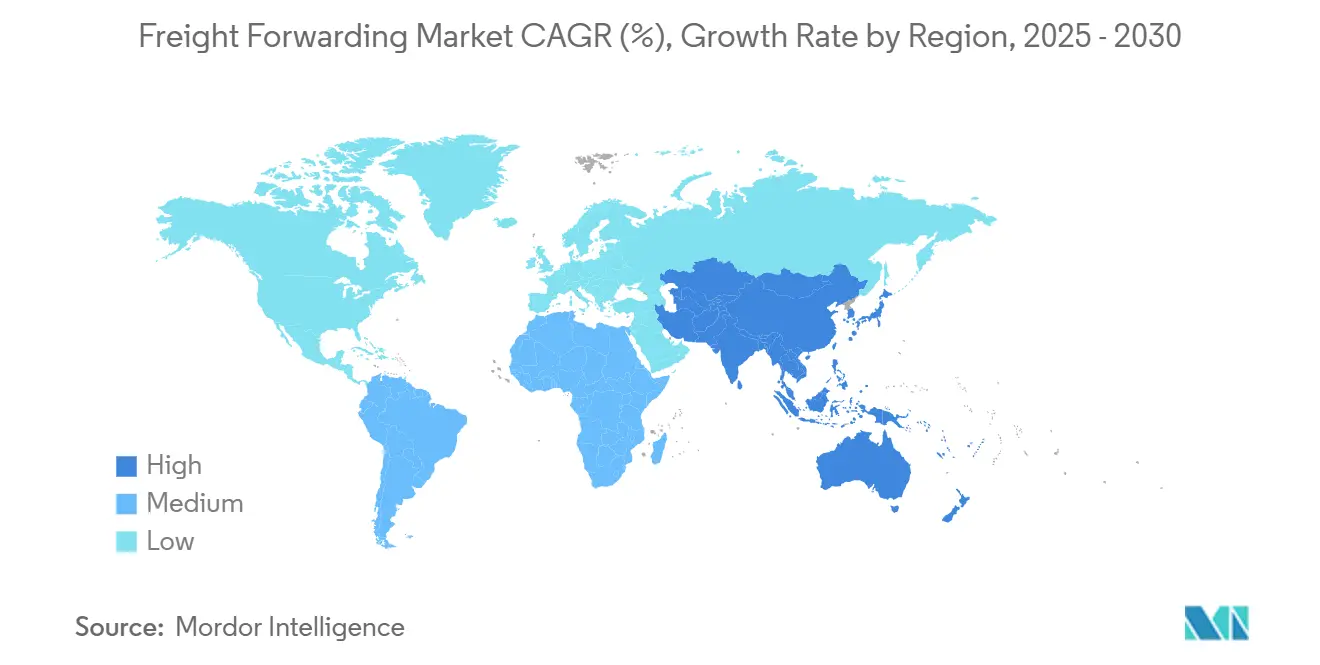
Competitive Landscape
Consolidation reshapes the freight forwarding market as scale economics tilt decisively toward mega-forwarders. The 2025 DSV-DB Schenker merger created the world’s largest player, instantly lifting a significant global gross revenue share and triggering competitive counter-moves. Carriers selling logistics arms to focus on core shipping further accelerate concentration, evident in ocean lines divesting forwarder subsidiaries to private-equity investors seeking platform roll-ups. Even so, niche specialists thrive by doubling down on life-science compliance, project cargo engineering, or cross-border e-commerce integration.
Technology remains the decisive battleground. Digital-native challengers such as Flexport publish all-in rates, photo-verified milestones, and carbon dashboards that resonate with data-driven shippers. Incumbents respond through internal incubators, joint ventures with cloud providers, and selective bolt-on acquisitions. Generative AI summarizes customs regulations, proposes multiple routing scenarios, and produces self-service rate cards that cut manual quote effort by 70%. Low-code apps empower branch-level staff to automate document templates, while API gateways integrate inventory feeds directly into ERP systems. As a result, total addressable market for digital forwarding services grows faster than headline freight forwarding market revenue.
Sustainability now shapes tender award criteria. European shippers increasingly earmark at least 20% of ocean allocations for carriers offering alternative-fuel vessels. Forwarders invest in route-level carbon calculators, aggregate biofuel certificates, and join green corridors that guarantee lower emissions per container. Competitive advantage therefore marries scale, technology, and demonstrable decarbonization progress. Mid-tier players that cannot fund both digital transformation and green initiatives risk relegation to niche subcontractor roles within broader platform ecosystems.
Freight Forwarding Industry Leaders
-
Kuehne + Nagel International AG
-
DHL Global Forwarding
-
DSV A/S (DSV Panorama)
-
C.H. Robinson Worldwide Inc.
-
Expeditors International of Washington Inc.
- *Disclaimer: Major Players sorted in no particular order
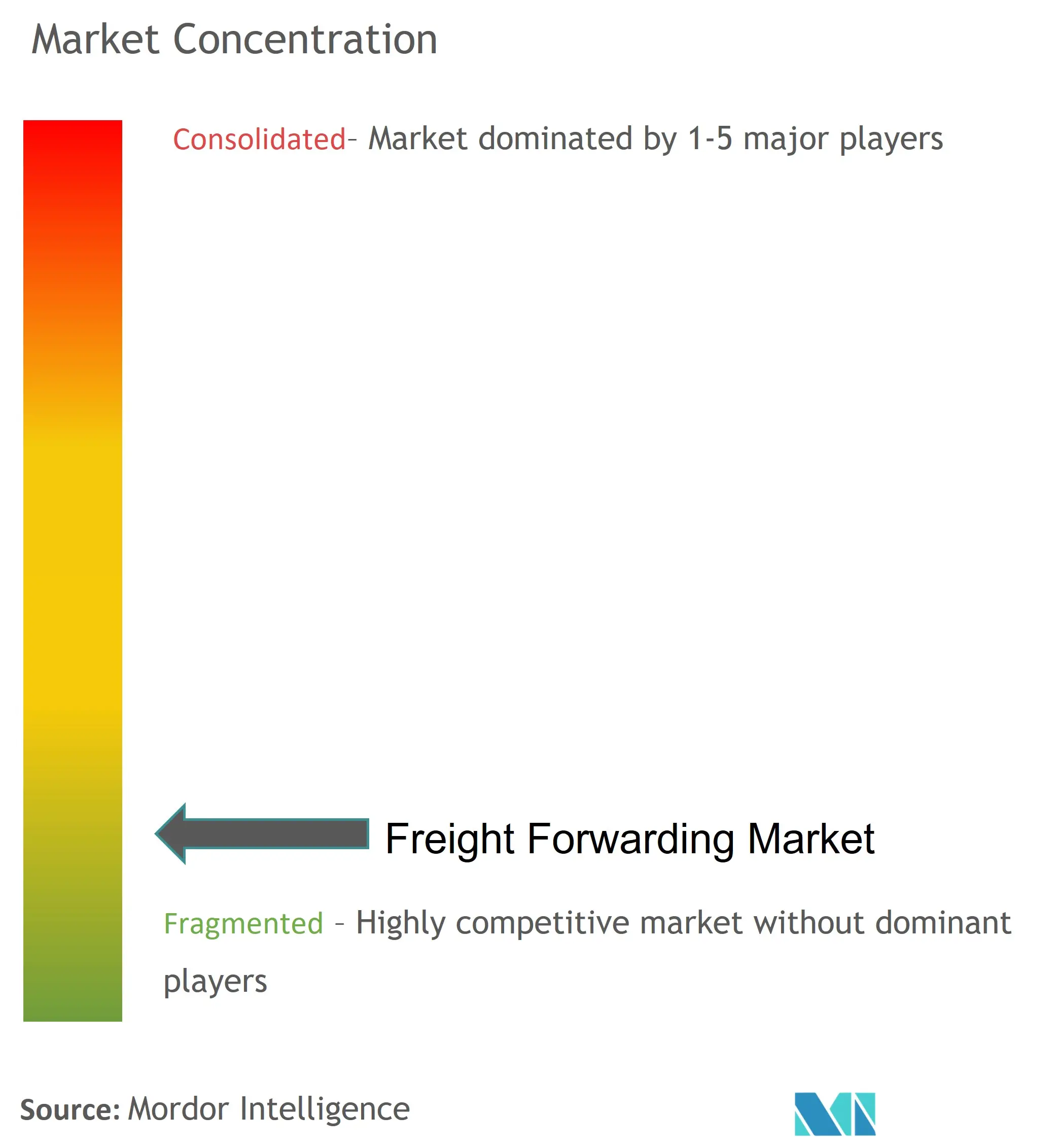
Recent Industry Developments
- May 2025: Leschaco enhanced Eurasian rail freight with daily block trains and new LCL services, expanding connectivity to Central Asia while ensuring EU customs compliance.
- April 2025: FedEx broadened SME-focused freight forwarding solutions across Asia, simplifying customs documentation and offering duty-inclusive quotes.
- April 2025: DSV completed the USD 15.9 billion acquisition of DB Schenker, integrating air, sea, and road networks under one control tower.
- February 2025: Maersk and Hapag-Lloyd launched the Gemini Cooperation, targeting schedule reliability and network optimization across 290 weekly ocean services.
Research Methodology Framework and Report Scope
Market Definitions and Key Coverage
We define the freight forwarding market as all gross revenue earned by licensed intermediaries that arrange international or domestic cargo movement across ocean, air, road, rail, and multimodal corridors, including related documentation, consolidation, customs brokerage, insurance facilitation, and value-added supply-chain services. According to Mordor Intelligence, revenue generated by internal carrier divisions that act as forwarders is counted, while pure trucking, warehousing-only contracts, and in-house shipper logistics teams remain outside the scope.
Scope exclusion: Dedicated parcel/CEP networks and asset-heavy trucking fleets offering no brokerage function are excluded.
Segmentation Overview
- By Mode of Transport
- Ocean Freight Forwarding
- Full Container Load (FCL)
- Less-Than-Container Load (LCL)
- Road Freight Forwarding
- Full Truck Load (FTL)
- Less-Than-Truck Load (LTL)
- Air Freight Forwarding
- Rail Freight Forwarding
- Multimodal and Intermodal Forwarding
- Ocean Freight Forwarding
- By Enterprise Size
- Small and Medium Enterprises
- Large Enterprises
- By Forwarder Model
- Traditional Asset-Light Forwarders
- Digital-First / Online Freight Platforms
- Others
- By End-user Industry
- Industrial and Manufacturing
- Retail and E-commerce
- Healthcare and Pharmaceuticals
- Oil, Gas and Energy
- Food and Beverages
- Automotive
- Chemicals
- Other End-users
- By Geography
- North America
- United States
- Canada
- Mexico
- South America
- Brazil
- Argentina
- Chile
- Rest of South America
- Europe
- Germany
- United Kingdom
- France
- Spain
- Italy
- Netherlands
- Russia
- Rest of Europe
- Asia-Pacific
- China
- India
- Japan
- South Korea
- Singapore
- Vietnam
- Indonesia
- Australia
- Rest of Asia-Pacific
- Middle East
- United Arab Emirates
- Saudi Arabia
- Turkey
- Israel
- Rest of Middle East
- Africa
- South Africa
- Egypt
- Nigeria
- Kenya
- Rest of Africa
- North America
Detailed Research Methodology and Data Validation
Primary Research
Interviews with senior forwarder executives, regional carrier partners, customs officials, and large B2B shippers across Asia-Pacific, North America, Europe, and emerging trade hubs help us validate service mix splits, average selling prices, and lane-specific growth assumptions. Follow-up surveys with SME exporters refine our e-commerce penetration inputs.
Desk Research
Our team reviews government trade datasets such as UNCTAD port throughput, IATA air-cargo market analysis, WTO tariff trackers, Eurostat freight indices, and US Census import-export statistics, which collectively outline cargo flows and pricing baselines. We also screen industry association white papers, peer-reviewed journals on logistics technology, and public filings to size forwarder revenue pools.
Next, we tap paid sources from Mordor's subscription stack, D&B Hoovers for company financials and Dow Jones Factiva for deal news, which sharpen competitor benchmarking. These references anchor our estimates, yet they are illustrative; many additional sources inform the final model.
Market-Sizing & Forecasting
We begin with a top-down construct that rebuilds forwarding revenue from global merchandise trade value and mode-wise freight cost ratios, followed by sampled ASP × volume checks on major lanes to ground the totals. Supplier roll-ups and port channel checks plug residual gaps before results are reconciled. Key variables like container freight indices, jet-fuel spreads, cross-border e-parcel counts, PMI manufacturing scores, and regulatory fee changes drive both the historical baseline and the five-year multivariate-regression forecast. Where bottom-up estimates undershoot due to private-company opacity, weighted averages from publicly listed peers are imputed and transparently flagged.
Data Validation & Update Cycle
Outputs face a three-layer review: automated variance scans, analyst peer audit, and finally our senior freight specialist sign-off. Mordor reports refresh annually, with interim updates triggered by material events such as tariff shifts or major M&A; a last-mile sense-check is run just before client delivery.
Why Mordor's Freight Forwarding Baseline Drives Reliable Decisions
Published estimates often diverge because firms count different services, convert currencies at varied dates, or refresh their models irregularly, and we acknowledge that reality upfront.
Key gap drivers include Mordor's inclusion of ancillary brokerage fees, multi-country revenue allocation, and an annual refresh cadence, whereas others may track only sea and air freight or stop at pure-play forwarders. Some peers apply uniform price escalators without lane granularity, while our analysts adjust for bunker-fuel surcharges, digital-platform mark-ups, and regional e-commerce momentum.
Benchmark comparison
| Market Size | Anonymized source | Primary gap driver |
|---|---|---|
| USD 572.25 B | Mordor Intelligence | - |
| USD 225.38 B | Global Consultancy A | Omits domestic forwarding and value-added services |
| USD 213.94 B | Industry Association B | Uses freight charges only, excludes digital and brokerage revenue |
| USD 184.94 B | Trade Journal C | Covers air and ocean modes but not road, rail, multimodal |
These comparisons show that Mordor's wider service coverage and disciplined refresh cycle produce a balanced, transparent baseline that decision-makers can trace back to clearly stated variables and repeatable steps.
Key Questions Answered in the Report
What is the current size of the freight forwarding market?
The freight forwarding market is valued at USD 572.25 billion in 2025 and is projected to grow to USD 740.85 billion by 2030.
Which region leads the freight forwarding market?
Asia-Pacific holds 36% of global revenue and is also the fastest-growing region with a 7.8% CAGR through 2030.
How fast are digital freight platforms expanding?
Digital-first forwarders are expanding at an 18.0% CAGR, significantly outpacing the overall market as shippers demand transparency and speed.
Which end-user sector is the fastest-growing?
Healthcare & pharmaceuticals leads growth with an 8.5% CAGR because of rising biologics volumes and stricter temperature-control requirements.
What is the main challenge in road freight forwarding?
A critical driver shortage in North America and Europe is lifting road freight rates and prompting shifts toward intermodal solutions.
How are forwarders addressing sustainability?
They deploy carbon calculators, partner on alternative-fuel corridors, and integrate emissions data into routing decisions to meet shipper decarbonization targets.
Page last updated on:



